| Shadows will cause livestock to balk and refuse to move in lairage pens, crowd pens, and races. | 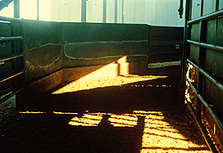 |
(Updated July 2022)
Cattle, pigs and sheep have wide-angle vision and they can see behind themselves without turning their heads. This explains why they will often balk at shadows or puddles of water on the ground.
| Shadows will cause livestock to balk and refuse to move in lairage pens, crowd pens, and races. |  |
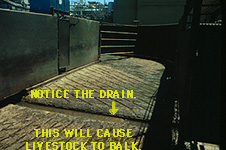 |
Drains should be located outside of the areas where animals walk. A drain or a metal plate running across an alley will cause balking because animals may refuse to step over it. |
Balking slows animal movement and can be prevented. Flapping objects such as a coat hung over a fence will also make livestock balk. When wetting pigs in the chute (race), be sure not to spray the animals' faces with water, because they will back up. In outdoor handling facilities, sharp shadows are more likely to cause stopping on bright sunny days. There may also be time of day effects. A sharp shadow may be absent in the morning and then appear later in the day.
Livestock tend to move from a darker area to a more brightly lighted area. Lamps can be used to attract animals into chutes. The light should illuminate the chute up ahead and it should never glare directly into the eyes of approaching animals. Another approach is illuminating the entire chute area. This approach eliminates patches of light and dark which may confuse animals. Move ceiling lamps off the centerline of the chute (race) to eliminate sparkling reflections on the floor.
| Curved single file race with solid sides at a meat plant. Cattle will move more easily through a curved race. | 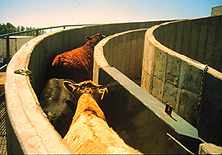 |
Solid sides which prevent the cattle from seeing people and other distractions outside the fence should be installed on the chutes (races) and the crowd pen which leads up to the single file chute. The use of solid sides is especially important in slaughter plants, truck loading ramps, and other places where there is lots of activity outside the fence. Solid sides are essential in slaughter plants to block the animal's view of people and equipment.
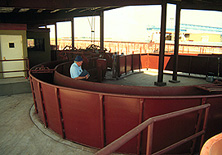 |
A curved chute (race) with solid sides at a ranch facility. It works better than a straight chute because cattle think they are going back to where they came from. The outer fence is solid to prevent the cattle from seeing distractions outside the fence. Some specialists in low stress handling methods prefer to have an open bar fence so that the cattle can see them and respond to their movements. This will only work with highly trained people who understand behavioral principles. The facility must be located in a pasture that has no nearby equipment, moving vehicles or extra people, or put inside a building that has solid side walls. In many facilities, adding solid fences will improve animal movement. This is especially important when animals with a large flight zone are handled by less experienced people. |
Solid sides in these areas help prevent cattle from becoming agitated when they see activity outside the fence -- such as people. Cattle tend to be calmer in a chute with solid sides.
| Cattle move more easily through the curved race system because they can not see people and other distractions ahead. | 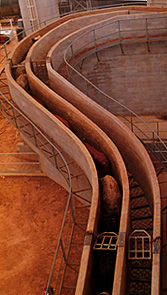 |
The crowd gate on the crowd pen should also be solid to prevent animals from attempting to turn back, towards the stockyard pens they just left. This is important on all types of systems.
It is important to reduce noise in the stunning area. Animals are more sensitive to high pitched noise than people. Animals will be calmer and easier to handle if noise levels are reduced. Install mufflers on air valve exhausts or put them outside. Rubber stops on gates can be used to stop clanging. Braking devices on the shackle return improves safety and reduces noise. Use large diameter plumbing and replace noisy pumps with quieter ones. Some brands of pumps are quieter than others. Rubber hose connection between the power unit and metal plumbing will help prevent power unit noise from being transmitted throughout the facility. Any new equipment that is installed in animal handling or stunning areas should be engineered for quietness.
PEOPLE SHOULD BE QUIET AND NOT YELL OR WHISTLE.
Grandin, T. 2021. The visual, auditory, and physical environment of livestock handling facilties and their effect on the ease of movements of cattle, pigs, and sheep. Frontiers in Animal Science. 07, October 2021.
Grandin, T. 1997. Low Stress Methods for Moving Cattle on Pastures, Paddocks and large Feedlot PensA commentary by Dr.Grandin on Bud Williams and his cattle handling techniques.
Grandin, T. 1996. Factors That Impede Animal Movement at Slaughter Plants. Journal of the American Veterinary Medical Association. Vol 209 No.4. pp. 757-759.
Grandin, T. 1993. Teaching Principles of Behaviour and Equipment Design For Handling Livestock. Journal of Animal Science. Vol 71. pp. 1065-1070.
Grandin, T. (Editor) 2007. Livestock Handling and Transport, 3rd Edition. CAB International. Wallingford Oxon, United Kingdom.
Grandin, T. 1991-2010. Recommended Animal Handling Guidelines For Meat
Packers and Good Management Practices for Animal Handling and Stunning. American Meat Institute. Washington DC, USA.
Grandin, T. 1987. Animal Handling - in E.O. Price (Editor) Farm Animal Behaviour. Veterinary Clinics of North America. Vol3:323-328.
Grandin, T. and Deesing, M. 2008. Humane Livestock Handling. Storey Publishing. North Adams, Massachusettes.
Willson, D.W., et al. 2021. An observational field study on the effect of changes in shadow contrasts and noise on cattle movement in a small abattoir. Meat Science. 2021, 108539.)
 Click here to return to the Homepage for more information on animal behavior, welfare, and care.
Click here to return to the Homepage for more information on animal behavior, welfare, and care.